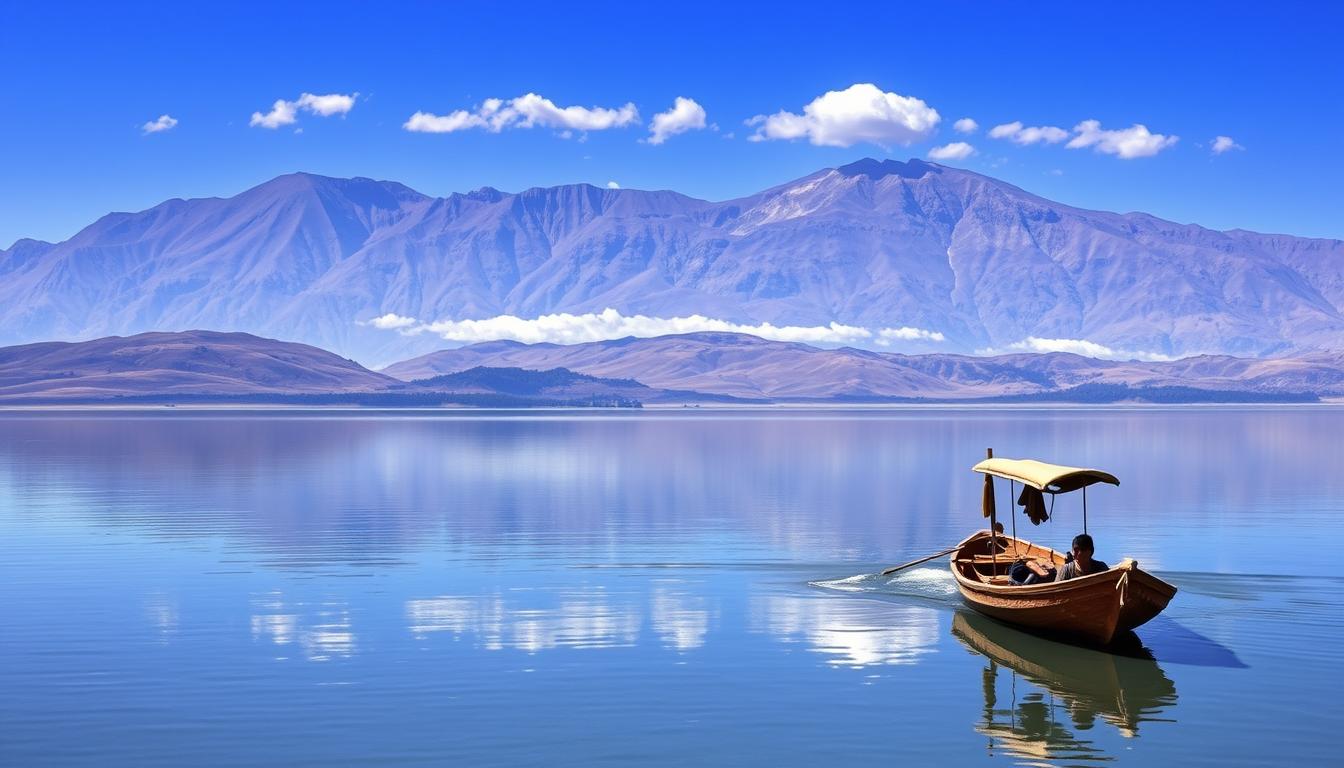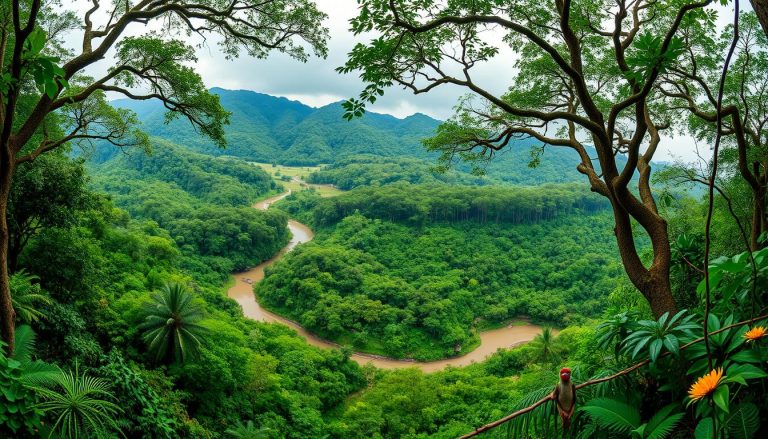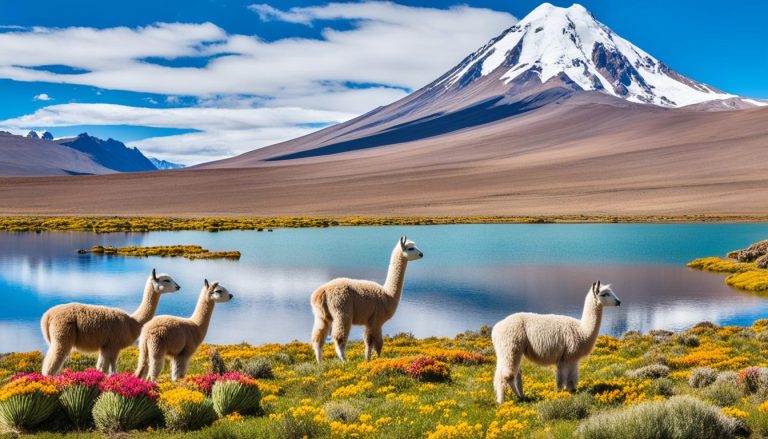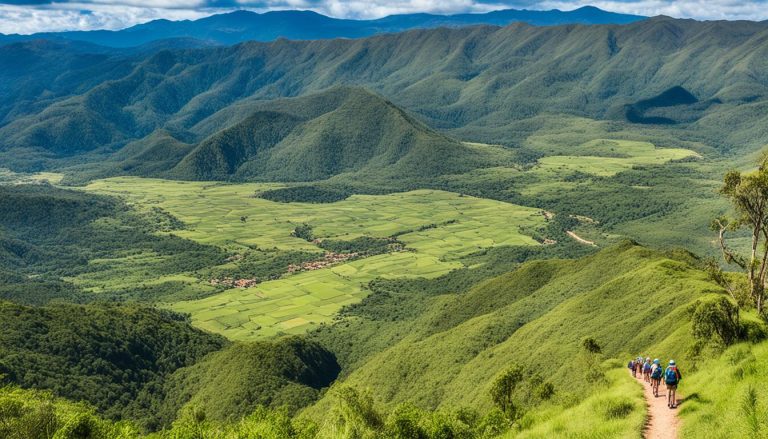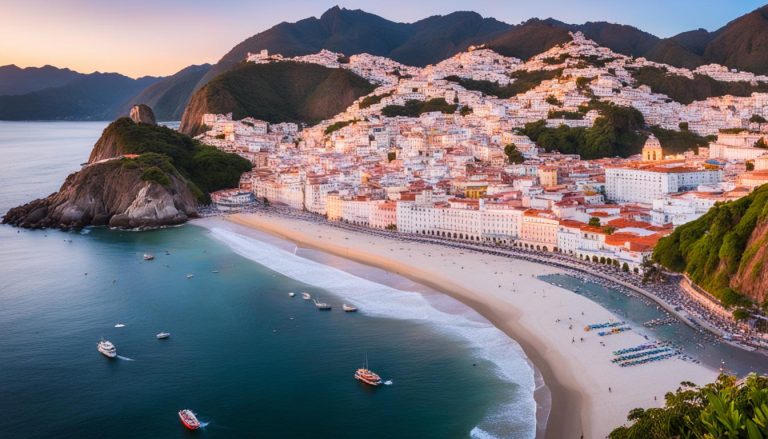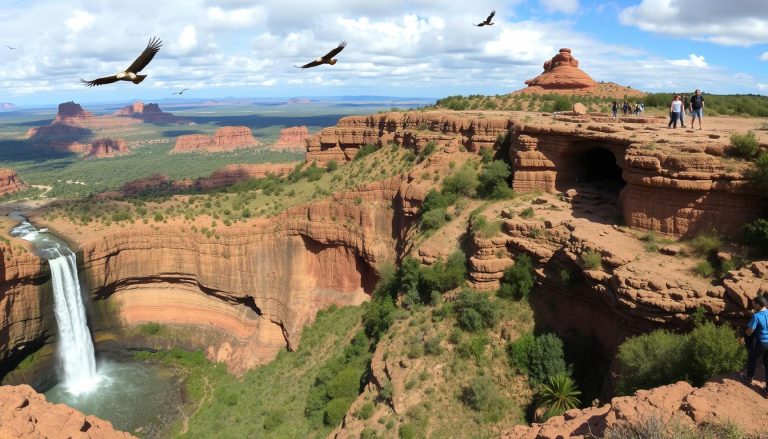Ever dreamed of seeing the world’s highest navigable lake? Welcome to Lake Titicaca, a stunning spot in Bolivia. It’s famous for its ancient ruins, island communities, and beautiful views. This place is perfect for travelers looking for new experiences.
Lake Titicaca lies between Peru and Bolivia, in the heart of South America. From Puno, you can go on amazing island tours. You’ll see the floating Uros islands, Taquile Island with its textiles, and Isla del Sol, where the Inca Empire began. There are also ancient ruins, villages, and trails to explore, showing off the area’s culture and beauty.
Key Takeaways
- Lake Titicaca is the highest navigable lake in the world, situated at an elevation of 12,500 feet.
- Explore the mesmerizing islands of Taquile, Amantani, and Isla del Sol, each with its own unique cultural traditions and ancient ruins.
- Discover the floating Uros islands, where local communities have woven their homes and boats entirely from reeds.
- Immerse yourself in the vibrant Puno culture, known for its annual Fiesta de la Virgen de Candelaria celebration.
- Hike through stunning landscapes and uncover the rich history of the Inca Empire and pre-Inca civilizations.
Are you ready for an unforgettable trip to the world’s highest navigable lake? Let’s explore the best things to do in Lake Titicaca together.
Overview of Lake Titicaca
Lake Titicaca is a stunning spot in the high Andes of South America. It combines natural beauty with ancient culture. At 12,500 feet above sea level, it’s the highest lake you can sail on. This makes it a place of breathtaking views and deep history.
Highest Navigable Lake in the World
Lake Titicaca is the highest lake you can sail on, thanks to its location in the Altiplano. It’s a favorite among travelers and adventurers. They come for its calm waters and the lively communities by the lake.
Mesmerizing Islands with Ancient Ruins
There are magical islands on the lake, each with its own story and history. You can visit the floating Uros Islands made of reeds or the ancient ruins of Isla del Sol. These places show the rich past and traditions of the local people.
Climate and Weather Conditions
Lake Titicaca has a dry climate, with days usually between 60°F to 65°F. But it gets cold at night, so bring warm clothes. The best time to visit is from April to November, when it’s sunny and nice. June, July, and August are the busiest months, with the best weather.
Lake Titicaca is perfect for those who love culture, nature, or unique travel spots. It’s a top destination in South America for anyone looking to explore something special.
Best Time to Visit Lake Titicaca
Exploring Lake Titicaca in Bolivia is best based on your preferences and the weather. We’ll look at the dry, rainy, and peak travel seasons to help plan your trip.
Dry Season vs. Rainy Season
The dry season at Lake Titicaca is from April to November. It has sunny and pleasant weather. Daytime temperatures are between 60°F to 65°F (15°C to 18°C). But, nights can get cold in June and July.
Sun protection is key during the dry season because the sun reflects off the lake. The rainy season is from December to March. January and February see the most rain. Clouds build in the morning, leading to afternoon showers and storms.
Peak Travel Season
June, July, and August are the peak travel months at Lake Titicaca. These months are dry and sunny, perfect for outdoor fun and island hopping.
| Season | Months | Weather Conditions |
|---|---|---|
| Dry Season | April to November | Sunny, pleasant; nighttime temperatures near freezing in June and July |
| Rainy Season | December to March | Afternoon showers and thunderstorms, with heaviest rainfall in January and February |
| Peak Travel Season | June, July, August | Sunny, pleasant weather during the dry season |
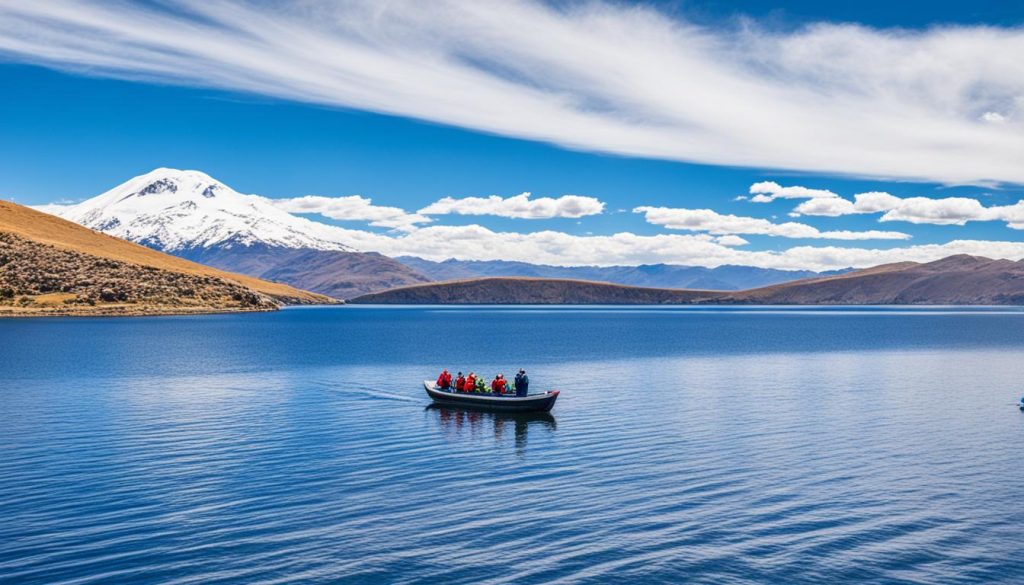
Whether you like sunny days or lush landscapes, Lake Titicaca is magical all year. Think about what you want and plan your trip to enjoy this high-altitude lake fully.
Geography and Location of Lake Titicaca
Lake Titicaca sits high in the Andes Mountains, on the border of southern Peru and western Bolivia. It’s the highest lake you can sail on, at 12,500 feet above sea level. This beautiful lake is a key part of the region’s geography.
The area around Lake Titicaca is mostly covered in grass and shrubs. Only a few trees can survive the high altitude. The city of Puno, with its population of about 130,000, is the main entry point for visitors. It’s known as the folkloric capital of Peru.
| Fact | Details |
|---|---|
| Elevation | 12,500 ft (3,810 m) |
| Population of Puno | Approximately 130,000 |
| Landscape | Grass and shrubs, few trees |
| Location | Southern Peru and western Bolivia |
Lake Titicaca’s location on the border of Peru and Bolivia makes it culturally rich and diverse. You’ll hear Spanish, Quechua, and Aymara languages here. This shows the mix of indigenous and colonial cultures in the area.
Learning about Lake Titicaca’s geography and location helps us understand its importance. The high altitude and vibrant communities make it a unique place to visit. It offers a deep dive into nature and culture.
History and Cultural Significance
Lake Titicaca’s history goes way back, even before it was split between Peru and Bolivia. Ancient cultures like Pukara, Tiahuanaco, Colla, Lupaca, and Inca lived by its shores. They saw the lake as sacred.
Birthplace of the Inca Empire
Legend says Viracocha, the Inca god of creation, came from Lake Titicaca. He made the sun, moon, stars, and people, starting the Inca Empire. The Inca saw the lake as a sacred place. They had important religious and cultural activities there.
Spanish Conquest and Colonization
The Spanish conquered the Inca Empire from 1531 to 1533. Francisco Pizarro led the troops in Cusco. Puno, a city founded in 1668, shows Spanish colonial influence. Its grand churches reflect the Catholic faith brought by the Spanish.
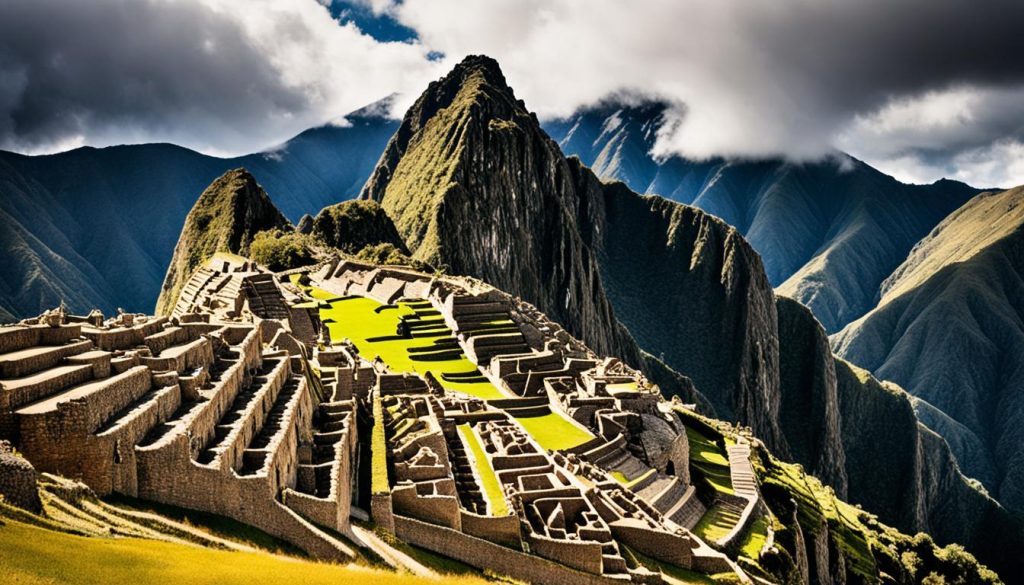
“The Inca Empire was a complex and highly advanced civilization that spanned much of South America, and Lake Titicaca was at the heart of its cultural and spiritual identity.”
Explore the Fascinating Islands
Lake Titicaca’s islands are full of diverse cultures, each with its own story. You can visit the Uros floating islands, Taquile Island with its ancient textiles, or the remote Amantani Island. There’s also the mythical Isla del Sol, all offering a chance to dive deep into local culture.
Uros Floating Islands
The Uros people moved to floating islands in Lake Titicaca centuries ago. They live in homes made of reeds on the water. Visitors can see their unique way of life and learn about their culture.
Taquile Island and Its Textile Art
Taquile Island is famous for its textile art, recognized by UNESCO. Both men and women there weave beautiful clothes, showing off the island’s history and skill.
Amantani Island: A Cultural Immersion
Amantani Island is seen as the most genuine of Lake Titicaca’s islands. It’s far away and has only 4,000 people. You can see how locals live, farming and raising animals.
Isla del Sol: Mythical Birthplace of the Incas
Isla del Sol, or the “Island of the Sun,” is said to be where the Incas were born. It has ancient ruins and places that honor its history. The Chincana ruins were a holy spot for Inca priests.
“Visiting the Lake Titicaca islands is a immersive cultural experience like no other, offering a unique glimpse into the traditions and ways of life that have endured for centuries on this remarkable inland sea.”
Lake Titicaca, Bolivia: Best Things to Do - Top Picks
Visiting Lake Titicaca in Bolivia is an adventure you won’t forget. You can go on island-hopping tours, kayak, or explore ancient ruins. This high-altitude lake is full of activities for travelers.
Island-Hopping Tours
Boat tours start from Puno’s docks or hotel piers. They let you hop from island to island. You’ll see the floating Uros Islands, all made of totora reeds. Here, you can learn about the Uros people’s traditional life.
Another spot is Taquile Island. It’s famous for its textiles and culture.
Kayaking on Lake Titicaca
Kayaking is a great way to see Lake Titicaca’s beauty. Tours begin at Coya point in Puno. You’ll paddle by totora reeds and maybe even visit a floating island.
This activity gives you a unique view of the lake and its landscapes.
Visit Ancient Ruins and Chullpas
Lake Titicaca isn’t just about islands. It has ancient ruins and chullpas too. The Sillustani towers are a highlight. They were built by the Colla tribe in the 10th century.
These towers show the area’s history and culture.
Lake Titicaca in Bolivia has something for everyone. It’s perfect for cultural experiences, outdoor adventures, or connecting with history. Make memories on this amazing high-altitude lake.
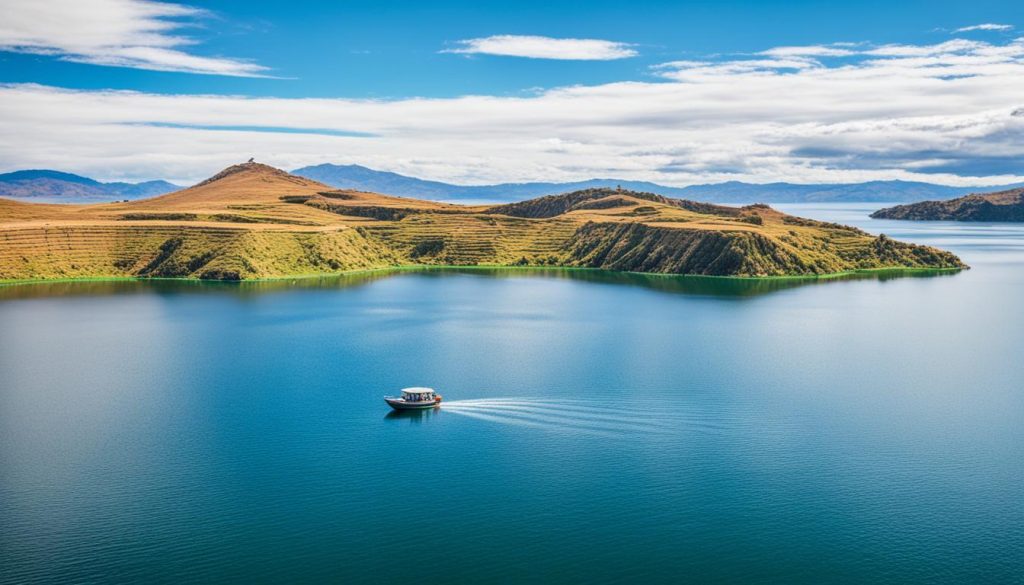
“Lake Titicaca is a true gem of Bolivia, offering a unique blend of natural beauty, ancient history, and vibrant cultural experiences.”
How to Get to Lake Titicaca
Lake Titicaca, on the border of Bolivia and Peru, is a top spot for travelers. It’s easy to get to from both countries. There are many ways to reach this famous lake.
By Plane
For those flying to Peru, the nearest airport is Inca Manco Cápac International Airport in Juliaca. It’s 30 miles from Puno. Flights from Lima and Cusco to Juliaca cost about $100 USD one way.
Once in Juliaca, you can take a bus, taxi, or private car to Puno.
By Bus
Buses are a great and affordable way to get to Lake Titicaca. The trip from Cusco to Puno takes 6-7 hours and is under $10 USD. Going from Lima to Juliaca takes 20-25 hours and costs about $50 USD.
By Train
For a luxurious trip, take the Andean Explorer train from PeruRail between Cusco and Puno. This 10-hour ride through the Andes is a favorite, costing around $270 USD.
No matter how you travel, Lake Titicaca’s beauty and culture are waiting for you. Start planning your trip now to experience its wonder.
Getting Around Puno and Copacabana
Exploring Puno, Peru, and Copacabana, Bolivia, is easy. This lets you dive deep into Lake Titicaca’s culture. In Puno, you’ll find most attractions, restaurants, museums, and shops near the main plaza. They’re all within walking distance. Hotels on the outskirts are just a short taxi ride away from downtown.
Boat tours to Lake Titicaca’s islands leave from Puno and Copacabana’s hotel piers. The trip from Copacabana to Isla del Sol takes about an hour and a half each way. You’ll see amazing views of the lake and its beauty.
| Location | Transportation Options |
|---|---|
| Puno |
|
| Copacabana |
|
These transportation options make it easy to see Puno and Copacabana’s best spots. You’ll make memories that last a lifetime on your Lake Titicaca trip.
“The ferry crossing from Copacabana to Isla del Sol is a must-do, offering breathtaking views of the lake and its surrounding landscapes.”
Health Concerns and Tips
Visiting Lake Titicaca in Bolivia is a breathtaking experience. But, you should keep some health tips in mind. The high altitude of 12,500 feet (3,800 meters) can cause altitude sickness for some.
To avoid altitude sickness, take it easy for the first 24-48 hours. Eat light meals and skip hard physical activities. This helps your body adjust.
High Altitude Sickness
Altitude sickness can cause headaches, nausea, dizziness, and loss of appetite. In bad cases, it can lead to coma or be deadly. Knowing the signs and getting medical help if needed is key.
Sunburn Precautions
The sun’s rays are very strong at Lake Titicaca’s high altitude. This increases your risk of sunburn. Always use sunscreen, hats, and other sun protection to keep your skin safe.
By following these health tips, you can enjoy Lake Titicaca’s beauty and culture safely. Listen to your body, drink plenty of water, and get medical help if needed. Your health and safety are most important.
Where to Stay and Eat
Visiting the stunning Lake Titicaca in Bolivia means finding the perfect place to stay. In Puno, you can choose from budget-friendly hostels like Los Uros Hostel and Duque Inn. For a bit more luxury, try Qelqatani Hotel or the elegant Titicaca Lodge Peru.
Don’t miss trying the local trout when you’re there. Puno and Copacabana have many restaurants with a “menu of the day”. This usually includes a soup, trout, and a sweet dessert, all for a good price. Alax Pacha is a favorite for its Bolivian dishes.
| Accommodation in Puno and Copacabana | Dining Options |
|---|---|
|
|
Looking for a budget-friendly stay or something more luxurious? Lake Titicaca has it all. Combine your stay with tasty local food for an unforgettable Bolivian trip.
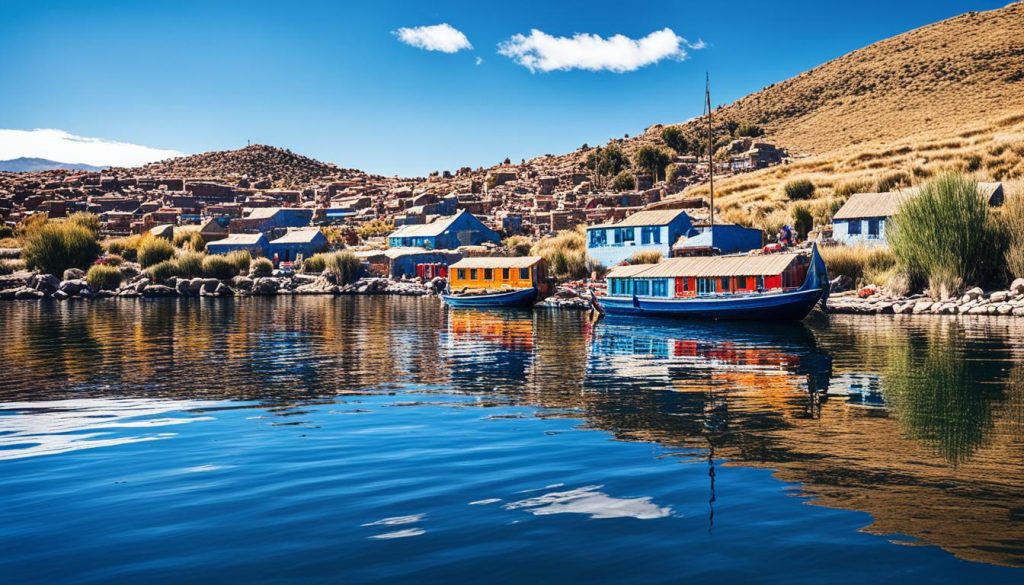
Conclusion
Your journey through Lake Titicaca, Bolivia, has ended, but the memories will stay with you forever. You’ve seen the floating islands of the Uros and the magical Isla del Sol. This lake, the highest you can sail on, has amazed you with its beauty, history, and culture.
You’ve enjoyed island-hopping, kayaking, and exploring ancient ruins. The Andes Mountains and the beautiful views left you in awe. The locals’ warm welcome made your trip unforgettable.
As you leave, think about what you learned and the friends you made. Lake Titicaca, Bolivia, has touched your heart deeply. You know you’ll come back to see more of this special place in South America.
